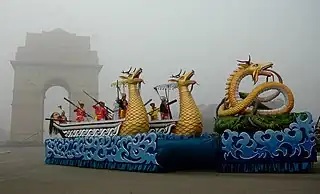Nungthel Leima
Nungthel Leima is a goddess in Meitei mythology and religion. She is an adopted daughter of God Koupalu (Koubru) and Goddess Kounu.[1] She is a wife of God Loyalakpa.[2][3] She is regarded as the deity of the Khunjahanba.[4] She is one of the incarnations of Leimarel Sidabi.
| Nungthel Leima | |
|---|---|
Goddess of the First Citizen | |
| Member of Lairembis | |
 "Nungthel Leima", the Ancient Meitei name of the goddess, written in archaic Meetei Mayek abugida | |
| Other names |
|
| Affiliation | Meitei mythology (Manipuri mythology) and Meitei religion (Sanamahism) |
| Texts | PuYas |
| Gender | Female |
| Region | Ancient Kangleipak (Antique Manipur) |
| Ethnic group | Meitei ethnicity |
| Festivals | Lai Haraoba |
| Personal information | |
| Parents | |
| Consort | Loyalakpa (alias Tollomkhomba or Tollongkhomba) |
| Term | |
|---|---|
| English | Nungthel Leima |
| Ancient Meitei | ꯊꯧꯇꯨ ꯅꯨꯡꯊꯦꯜ ꯂꯩꯃ (thou-too noong-thel lei-ma) |
| Modern Meitei | ꯊꯧꯗꯨ ꯅꯨꯡꯊꯦꯜ ꯂꯩꯃ (thou-doo noong-thel lei-ma) |
| Assamese | নুংথেল লৈমা (noong-thel lei-ma) |
| Bengali | নুঙথেল লৈমা (noong-thel lei-ma) |
| Hindi | नूंथेल लैमा (noong-thel lei-ma) |
| Sanamahism | |
| Part of a series on |
| Meitei mythology |
|---|
 |
|
|
| Part of a series on |
 |
| Sanamahism |
| Category |
| Primordial deities |
|---|
| Saiyon Langgon |
| Religious texts |
| Religious Symbolism |
|
| Ancient Sites in Manipur |
|
| List of figures in Meitei mythology |
| Religious roles |
| Religious buildings & institutions |
| Religious festivals |
| Lai Halaopa and its holy dances |
| Sanamahism & other religions |
| Related topics |
Etymology
The name "Thoudu Nungthel Leima" (ꯊꯧꯗꯨ ꯅꯨꯡꯊꯦꯜ ꯂꯩꯃ, /tʰəu.du núŋ.tʰel lə́i.ma/) or "Thoudu Nungthen Leima" (ꯊꯧꯗꯨ ꯅꯨꯡꯊꯦꯟ ꯂꯩꯃ, /tʰəu.du núŋ.tʰen lə́i.ma/) is made up of three Meitei language words, "Thoudu Nung" (ꯊꯧꯗꯨ ꯅꯨꯡ, /tʰəu.du núŋ/), "Thel" (ꯊꯦꯜ, /tʰel/) or "Then" (ꯊꯦꯟ, /tʰen/) and "Leima" (ꯂꯩꯃ). In Meitei language (Manipuri language), "Thoudu Nung" (ꯊꯧꯗꯨ ꯅꯨꯡ, /tʰəu.du núŋ/) means "stone". This term is typically used in poems and verses.[5] In Meitei language (Manipuri language), "Thel" (ꯊꯦꯜ, /tʰel/) or "Then" (ꯊꯦꯟ, /tʰen/) means "to display" or "to show".[6] In Meitei language (Manipuri language), "Leima" (ꯂꯩꯃ, /lə́i.ma/) means "queen". The word "Leima" (ꯂꯩꯃ, /lə́i.ma/) itself is made up of two words, "Lei" (ꯂꯩ, /lə́i/) and "Ma" (ꯃ, /ma/). "Lei" (ꯂꯩ, /lə́i/) means "land" and "Ma" (ꯃ, /ma/) means "mother".[7]
Description
Goddess Thoudu Nungthel Leima is described as the deity of the Khunjahanba.[4] Khunjahanba means "the first villager" or "the first citizen of a place". In Meitei language (Manipuri language), "khunja" (ꯈꯨꯟꯖꯥ, /kʰun.ja/) means "a villager". Morphologically, "khunja" (ꯈꯨꯟꯖꯥ, /kʰun.ja/) is divided into "khun" (ꯈꯨꯟ, /kʰun/) and "-ja" (ꯖꯥ, /ja/). "Khun" (ꯈꯨꯟ, /kʰun/) means "village" and "-ja" (ꯖꯥ, /ja/) literally means "offspring".[8] In Meitei language (Manipuri language), "Ahanba" (ꯑꯍꯥꯟꯕ, /ə.han.bə/) means "the first" or "the initial".[9]
Mythology
Birth, adoption and naming
Goddess Leimarel Sidabi incarnated herself as a little girl and laid herself on a stone slab in the riverbed. On the same day, God Koubru and Goddess Kounu were walking in a nearby place. God Koubru got very thirsty. So, he went down the riverside to drink water. He found the girl on the river bed. Koubru shouted three times asking if there was anyone for the baby girl. Since no one responded, Koubru and Kounu brought the girl to their divine home.[10] The girl was adopted as their own daughter. She was given three names. She was named "Ipok Leima" ("Eepok Leima") because she was found in the stream. She was also named "Thoudu Nungthel Leima" because she was found lying on the stone slab. She was given her final name as "Taipang Nganpi" ("Taibang Nganbi") because she was beautiful as well as bright.[11]
Husband and suitor
Nungthel Leima is married to God Loyalakpa. However, she was once admired by God Khoriphaba. Once Khoriphaba was offered a chance by God Koubru to choose any lady of his own desire from the latter's place. Unfortunately, Goddess Nungthel Leima was chosen by Khoriphaba. But since Nungthel Leima was already married, God Koubru could not give Khoriphaba the chosen lady. Koubru did not want to take back his own words. So, he asked Khoriphaba to choose a lady once again but he should do it blindfolded. Blindfolded Khoiriphaba tried to choose but could not get Goddess Nungthel Leima. This event is enacted by the maibis in the Lai Haraoba festival till present times.[12][1]
Festival
The sacred Lai Haraoba festival is annually celebrated in honor of goddess Thoudu Nungthel Leima, besides other deities.[4]
Cults and pantheons
On 19 January 2018, a newly constructed temple of Ema Nungthel Leima was inaugurated at Top Siphai by Oinam Lukhoi, the then MLA of Wangoi Assembly Constituency. During the inaugural event, Oinam Lukhoi announced on the proposals to Manipur State Government to re-develop the existing sacred temples in the Wangoi AC, including other temples of goddess Nungthel Leima.[13]
In popular culture
Nungthel Leima Tollomkhombada Thajaba is a book written by Naoroibam Khamba. It was released on 17 January 2021.[14][15][16]
References
- Session, North East India History Association (1995). Proceedings of North East India History Association. The Association. p. 96.
- Session, North East India History Association (1982). Proceedings of the North East India History Association. The Association.
- Devi, Lairenlakpam Bino (2002). The Lois of Manipur: Andro, Khurkhul, Phayeng and Sekmai. Mittal Publications. p. 55. ISBN 978-81-7099-849-5.
- Devi, Lairenlakpam Bino (2002). The Lois of Manipur: Andro, Khurkhul, Phayeng and Sekmai. Mittal Publications. p. 54. ISBN 978-81-7099-849-5.
- Sharma, H. Surmangol (2006). "Learners' Manipuri-English dictionary.Thoudu Nung". dsal.uchicago.edu.
- Sharma, H. Surmangol (2006). "Learners' Manipuri-English dictionary.then". dsal.uchicago.edu.
- Sharma, H. Surmangol (2006). "Learners' Manipuri-English dictionary.Leima". dsal.uchicago.edu.
- Sharma, H. Surmangol (2006). "Learners' Manipuri-English dictionary.Khunja". dsal.uchicago.edu. Retrieved 2022-03-31.
- Sharma, H. Surmangol (2006). "Learners' Manipuri-English dictionary.Ahanba". dsal.uchicago.edu. Retrieved 2022-03-31.
- Neelabi, sairem (2006). Laiyingthou Lairemmasinggee Waree Seengbul (in Manipuri). p. 43.
- Neelabi, sairem (2006). Laiyingthou Lairemmasinggee Waree Seengbul (in Manipuri). p. 44.
- "Maibi's, Kanglei Thokpa / Lai Nupi Thiba. Trance Dance of Lai Haroaba". sevensistersmusic.com.
- "MLA Lukhoi bats for renovation of religious sites : 20 Jan 2018 ~ E-Pao! Headlines". e-pao.net.
- "'Nungthel Leima Tollomkhombada Thajaba' released 18 Jan 2021 ~ E-Pao! Headlines". e-pao.net.
- "'Nungthel Leima Tollomkhombada Thajaba' to be released". www.thesangaiexpress.com.
- "'Nungthel Leima Tollomkhombada Thajaba' to be released : 15 Jan 2021 ~ E-Pao! Headlines". e-pao.net.
Further reading
- Tensuba, Keerti Chand (1993). Genesis of Indian Tribes: An Approach to the History of Meiteis and Thais. Inter-India Publications. ISBN 9788121003087
- Khamba, Naoroibam (2021): Nungthel Leima Tollomkhombada Thajaba
